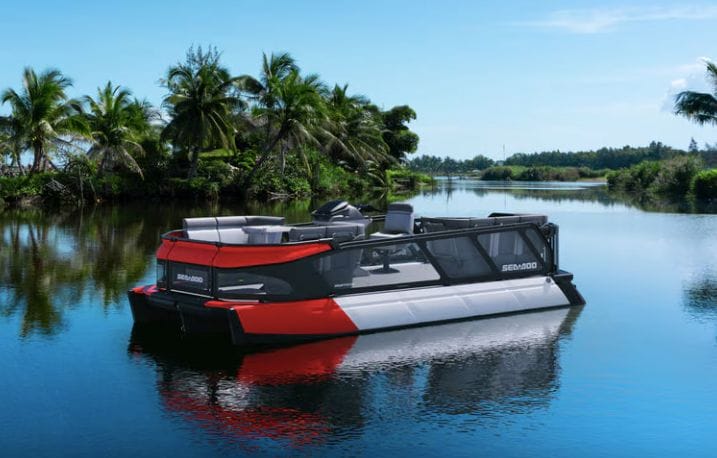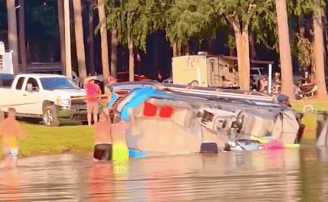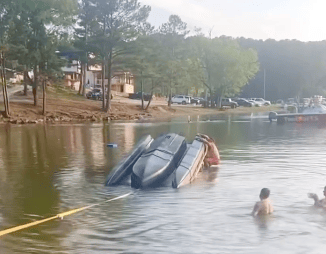
Families in danger, say some Sea-Doo Switch users as ‘pontoon’ style boats flip out

As BRP announced it’s selling its marine businesses – excluding Sea-Doo personal watercraft, Sea-Doo Switch pontoons, and jet propulsion systems – MIN takes a look at the online safety concerns surrounding the pontoon-style boats its decided to keep.
The Sea-Doo Switch lineup is having a tough time online, and occasionally in the water. Billed as accessible, adaptable and fun for the whole family it’s a pontoon boat – a staple favourite in the US – built with more than a nod to a jet ski. But, according to Peter Swanson, a number of incidents have made the news when Sea-Doo Switch pontoon boats have flipped, raising concerns.
And while many keen boaters may be sceptical – perhaps thinking user error – there are questions being raised about the outer hulls, ballast water, and marketing to entry level boaters as a ‘family’ craft.
“This is a story about a fairly new production boat . . . . call it a ‘handling quirk’ for now. It’s only when it lands in court as a wrongful-death case that it may officially become a design flaw’,” says Swanson, who writes online under the name Loose Cannon).
Switch pontoon boats outlined
Switch pontoons have a jet propulsion system and handlebar steering with the same ‘intuitiveness’ as a Sea-Doo Personal Watercraft. They feature Sea-Doo’s brake and reverse system, which BRP (the manufacturer Bombardier Recreational Products) says makes the pontoons the only ones on the water with brakes. Plus, they have cruise control.
Construction is a tri-toon design. This means the outer pontoons sit slightly higher than the middle. It has modular accessories so can be adapted to any day on the water.
But, some models – in a range that runs through fishing, sport and cruising – can flip if conditions go awry.
Family’s Sea-Doo Switch flips in river, trapping baby
In September this year, it was reported that a Florida family’s Sea-Doo Switch Pontoon boat (seemingly the shortest model) flipped over in the St. Johns River, trapping an infant underneath it. The baby was fortunately rescued by a firefighter who happened to be passing the marina entrance.
Clay County Fire Rescue Lt. Thomas Gill and colleague Lt. Joe Hutchins heard the shouts. They ran to the end of the marina dock and saw a father and son in a boat and asked to be taken to the scene. People were trying to help three victims get on top of the capsized boat while a man yelled his daughter was trapped underneath.
“I didn’t even think about it,” Gill told local media. “I took the stuff out of my pockets and got in the water. I was acting on instincts and adrenaline.” Seemingly he was underwater for so long that Hutchins thought he had drowned.
“I tried opening my eyes a couple of times, but it stung too much,” Gill said. “You couldn’t see anything anyway. I kept reaching, but I couldn’t feel anything. I knew the adults weren’t wearing PFDs [personal floatation devices], but the baby was.
“I was trying to look for a better area to find her. The complete boat is at the water level, so there are no air pockets. She’s just trapped underneath.
“I kept reaching, and I finally felt a leg. I got her and pushed her to the surface. I don’t know how long I was under; I don’t know how much longer I could have lasted. But I wasn’t coming up back up without her.”
Gripes about mechanical problems with Switch
Swanson has spent time investigating the handling characteristics of the Switch, in order to try to ascertain what the problem might be, like in the incident outlined above.
He says that while many owners love their Switch, some have gripes about mechanical problems and customer service.
“Some owners posted [online] about the need to respect weight limits and distribution, but often accompanied by descriptions of close-calls happening when the throttle lever was released,” Swanson explains. He cites one user who said: “You have to slow down gradually. If you slow down fast, it will bury the nose and you can flip it.”
Another mentioned: “This [flipping] happened to me twice. The first day I had it, I had let off the throttle suddenly. Now I reduce speed slowly. Second time, there was a big wave as I was coming into a no-wake zone. . . . . It is really scary. I’m pretty sure my niece will never get on my boat again.”
Sea-Doo Switch complies with all ABYC and US Coast Guard regulations
BRP spokesperson, Emilie Proulx, says Sea-Doo Switch watercrafts comply with all ABYC and US Coast Guard regulations regarding flotation testing and weight capacity. “This product has been rigorously tested throughout its development phase and still is today. As such, BRP strongly believes that the Sea-Doo Switch watercraft is a well designed and safe product,” Proulx says.
Some Switch owners say user error at fault
“We have driven this boat on the channel with giant barges and yachts going by, hit giant swells and insanely choppy water, and the Switch rolls right over them,” says a user on Reddit. “It’s not heavy enough to barrel through them like the big-ass pontoon boats do, but the balance and manoeuvrability of the Switch compensates for that.
“Just like any boat, you need to be aware of weight distribution and adjust your driving appropriately, but with skill and proper attention to your environment, there’s no reason this Switch should ever flip. If someone flipped it, I would suspect user error or pure stupidity was at fault.”
BRP expands with the growth in pontoon boat market
Swanson says that BRP has taken advantage of a rapidly growing segment of the marine marketplace—pontoon boats. Traditional pontoon boats tend to be slow and stable. He says the only thing that the Switch has in common with pontoon boats is the use of the word ‘pontoon’ in its name, and multiple hulls.
 Image courtesy of BRP marketing materials
Image courtesy of BRP marketing materialsDepending on which model, Switch can carry between five and nine people, has a top speed of over 35mph and pricing that starts at under $30,000 for the 13ft model. They are budget friendly, fast and fun.
“BRP leveraged its long experience in the PWC market (commonly, jetskis) to create a tri-hulled hybrid propelled by a Rotax water jet. The vessel has a jetski handlebar helm offset to starboard, while the engine mounts in the central hull, which happens to be shaped like that of an oversized jetski. Seat positions are designed to balance the boats, but Seadoo touts the ability of owners to re-arrange the furniture somewhat,” Swanson says.
Outer hulls means Switch leans into turns like a jetski
The outer hulls of the Switch are smaller and don’t project as far down into the water as the one in the middle. This enables the Switch to lean into turns like a jetski.
“The hulls comprise multiple segments whose number determines LOA, whether the hull is 13, 16 or 19ft long. The segments are purposely not sealed, so water seeps into the hulls, supposedly to add weight and thus stability at rest. The ballast water then flows out through an opening out the back when underway or when hauled out,” Swanson explains.
He visited a Seadoo dealer to ask about this characteristic and says that the salesman did not hesitate to acknowledge the boat’s propensity to flip when suddenly decelerating, particularly in choppy water or in combination with a turn.
“But he said he did not know exactly how much ballast water the outer hulls could hold, noting that it is not specified in any of the manuals or training literature. A gallon of water weighs 8.34 pounds. Our salesman guessed maybe two gallons. Owner Facebook posts suggested it could be more. A worst case might be 10 gallons per hull.
“If a Switch were at rest and then got underway long enough to lose five of the ten gallons out the back, and were then throttled down, a combined 80 pounds of water could be sent hurtling forward, filling the empty space and helping to force the bow down.”
A Florida manufacturer who has built all types of recreational vessels at his Gainesville factory over the past 50 years, told Swanson: “I’m a boatbuilder. In cases like these, I usually give the manufacturer the benefit of the doubt, but I’ll say this, nothing being sold as a pontoon boat should capsize on the St. Johns River.”
MIN asked BRP about the capsize on the St. Johns River, and the Clay County rescue. “With regards to the incident you reported, it is still under investigation and, consequently, we will not be commenting on this specific matter,” says Proulx.
Other reported incidents of Switch flipping
After a different incident in the USA (recovery footage below) the owner, Xavier Sotomayor, went on to Facebook explain what had happened and the factors which he believes all contributed to the accident.


Images and video courtesy of Boatzone Instagram.
“We had seven people on there [in] total. Went out to a cove and hung around for about four hours sitting still, tied-up. After pulling out we noticed, on the way back, the boat was only doing about 8-9mph. We noticed the anchor was still down flowing in the current of the water. Pulled it up and and slowly gave it throttle went back up to normal cruising speed 22-24mph, not once expecting that water completely filled the toons and also the engine compartment storage area.
“A hat flew off so we slowed and turned to the right causing all the water in the hull to move to one side as well as having two people reach for it.
“At the same time there happened to be two wake boarding boats came by in front causing three foot wakes which came over the front.
“The combination of everything caused the boat to nose dive and eventually slow roll over.”
Mistake of stopping too fast, says one Switch user
Brian Garrison, a Switch owner, has written detailed instructions online, says Swanson, on how to avoid the issue like Sotomayor encountered. He decided to do this after his wife was over-enthusiastic on the brakes.
“She made those mistakes of stopping too fast,” says Garrison, “and we had way too many people in the front for that. The nose dipped, and luckily we didn’t capsize. I was hanging off the back leaning out over the water like a pirate and yelling for everyone to get to the back of the boat. Thankfully, everyone got there fast enough to bring the nose up. So, yeah, don’t overweight the front and then stop fast.”
He advises: “Slow down evenly and gradually. Then when your wake catches up to you, just before it hits, increase gas slightly to counter the push of the wake on the back of the boat, then ease off again. repeat to keep the bow up until the wake evens out and the boat settles. Basically, stopping too fast can cause the momentum of the boat to push the nose down, if you combine that with the push that the boat’s own wake catching up to it, that also causes the nose to dip. Combine that with any waves you may hit, that could further dip the bow. Combine that with too much weight in the front, and you have a bad day.
“So, just ease gradually down on the gas and counter the bow dip with small increases in gas to keep the bow up until the boat settles.”
Issue with BRP marketing to families at entry level
Sotomayor says he still loves the Switch but has an issue with BRP marketing to ‘families that have jet skis, but now want a boat for the family’.
No one got hurt in this incident, there were just a few missing phones, but Sotomayor says in his Facebook post: “There should be a warning sensor/light indicating there is water in the hull/engine/storage area or at minimum an AUTO Bilge pump. Not everyone is going to open up their engine compartment every time [they are] going out boating and more than likely neither will be a first time boater after sitting for a while with friends and family.”
BRP takes incidents seriously
“We provide our users with safety information (user guide, product labels, safety video, etc.) and design features to ensure that our products are used safely,” says BRP’s Proulx. “Having said that, BRP takes any incident with its products very seriously.”
In Jan 2023, Julie Tourville, director of global marketing, Marine Group and Sea-Doo at BRP said: “The Sea-Doo Switch is designed for the next generation of boaters. We wanted to disrupt the industry with a pontoon that marries the spirit and fun of the Sea-Doo brand, and we’ve done it with the Switch. It’s built to change the realities of what life on the water can be and provides the flexibility to fit the dreams of all kinds of recreational water lovers. The accessibility was also key to bring in first-time boat owners to the category.”
Concerns for new boat owners
But those first-time boat owners are worrying for more than Sotomayor.
“These folks want to get out on the water and have fun with their families on weekends, not to become versed in the nuances of vessel stability,” says Swanson.
“The warning sticker at the Seadoo helm cautions against overloading the boat and to “ensure that weight is evenly and properly distributed,” but it says nothing about the hazards of sudden deceleration. Neither does the owners manual, which does say that capsizing is unlikely: ‘This watercraft is designed so that it should not turn over easily due to its long and wide dimensions’.
“Brian Garrison’s somewhat complicated primer on how to not flip should be considered in the context of the Switch market, some combination of likely jetski and pontoon consumers. Apologies in advance to pontoon-boat owners for this generalisation: Pontoon boaters are probably not the most savvy mariners on America’s waterways. Many Switch people are probably first-time boat buyers.”
Images below and main image courtesy of @MWAAFireRescue who were first on the scene and removed eight from the Potomac River in July 2023.
Update overturned boat Potomac River. @MWAAFireRescue first on scene and actually removed 8 from water. All uninjured. DC Fireboats and @DCPoliceDept Harbor Units were also on scene assisting. #DCsBravest pic.twitter.com/OK9LZckAwV
— DC Fire and EMS Department (DCFD) (@dcfireems) July 2, 2023
The post Families in danger, say some Sea-Doo Switch users as ‘pontoon’ style boats flip out appeared first on Marine Industry News.

